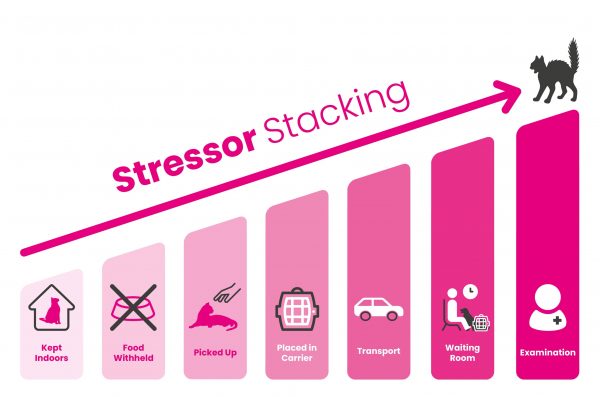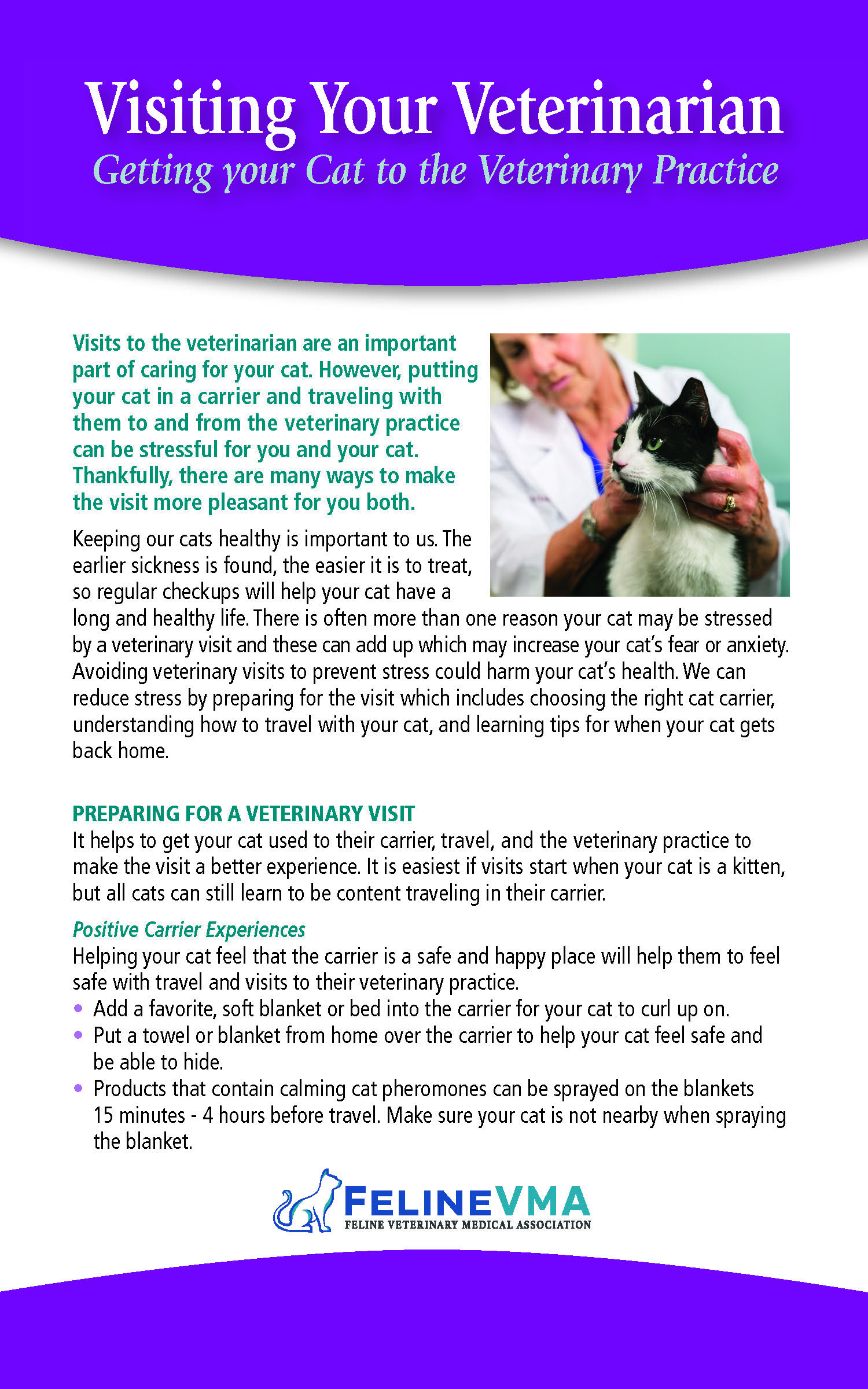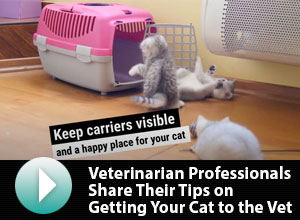Providing your cat with good health care, especially preventive health care, can allow her to live a longer, more comfortable life. However, this cannot happen unless you take your cat to see the veterinarian routinely.
Many cats are fearful or distressed when going to the veterinarian because the practice is unfamiliar, as is the carrier and the car. Here are some tips to make trips a positive experience for you and your cat. You can also learn about selecting the perfect cat carrier.
Why is My Cat Fearful of Her Carrier?
Cats are most comfortable with the familiar and need time to adjust to the unfamiliar. If the carrier is not an object in your cat’s regular environment, they will not be familiar with it. Respect your cat’s need for time to become familiar with new situations, people, and places.
Make Your Cat’s Carrier a “Home Away From Home”
Many people keep the carrier in the basement or garage and only get it out right before a trip to the veterinarian. Instead, make the carrier a part of your home environment. This way your cat sees it as a safe place and learns to associate positive experiences with the carrier before being transported in it. Also, consider choosing the right carrier that is sturdy and has both a top and front entrance. Here are some ways to help your cat become more comfortable with the carrier:
- Make the carrier a regular part of your home by keeping it out in a room where your cat spends a lot of time. Include familiar, soft bedding inside the carrier. Bedding or clothing with your scent can make your cat feel more secure.
- Place treats, catnip, or toys inside the carrier to encourage your cat to enter it at home. Often, you will first see that treats are removed from the carrier during the night.
- While your cat adjusts to the carrier, don’t coax him to go in – your cat may get suspicious.
- You can also use a synthetic feline pheromone spray or wipe in the carrier, which may minimize anxiety associated with the carrier.
- It may take days or weeks before your cat starts to trust the carrier. Remain calm, patient, and reward desired behaviors.
- If you still have trouble, you may need to assess the carrier itself and find a carrier that your cat likes. Your veterinarian can help you with carrier recommendations.
- A new carrier is sometimes important because the stress pheromones released in previous car rides may still be present. At the very least, clean the carrier thoroughly with a non-scent cleanser, rinse well, and leave it in the sun to dry for a day.
- Also, hold the carrier from the bottom and not just the handle which will make your cat feel unstable.
- Once your cat is comfortable with the carrier, take your cat (with their favorite treat) for short “test drives” in the car to get her used to car travel.
Getting a Cat into the Carrier
If your cat needs to be transported immediately to the veterinarian or due to another emergency situation and is not yet used to the carrier, the following tips may help:
- Start by putting the carrier in a small room with few hiding places.
- Bring your cat into the room and close the door. Move slowly and calmly.
- Do not chase your cat to get her into the carrier as this will make her more scared
- Encourage your cat with treats or toys to walk into the carrier.
- If your cat will not walk into the carrier, and your carrier has an opening on the top, gently cradle your cat and lower her into the carrier.
- Another option is to remove the top half of your carrier while getting your cat to go into the bottom half, and then calmly replace the top. It may be necessary to wrap her in a towel to prevent outstretched legs from getting in the way.
Avoid “The Chase”
Don’t wait until five minutes before you have to leave, and then start pursuing your kitty. This can increase your cat’s fear and make you more likely to get bitten or scratched. Instead, if your cat is carrier trained, withhold food for a few hours, and then toss a few pieces of the cat’s favorite treat into the carrier. Your cat should walk right in. Otherwise, calmly walk into the room where your cat is sitting, close the doors, pick up your cat, and put him in the carrier just as you practiced when you acclimated your cat to the carrier. If your cat gets very scared while getting her in the carrier and on the ride to the practice, then her stress is going to continue to increase. Try to remain calm. If your cat has not gotten used to the carrier even with practice, talk to your veterinarian about giving your cat medication before the visit to help her stay calm.

Cover the Carrier During Travel
Once your cat is in her carrier, cover it with a towel or blanket to block her view of the changing surroundings. Carry the carrier with your cat in it (only 1 cat per carrier!) with both arms like a valuable package when transporting to and from the car—this will help her feel safer.
Securing Your Cat in the Car
The Center for Pet Safety recommends that carriers be seat belted into the backseat only if they have been crash tested. Most carriers should be placed on the floor behind the driver or front passenger seat. It is dangerous to allow your cat to roam free within the car. If your cat is unsecured, she can be subject to severe injury in the event of an accident. Also, she may interfere with your driving if he comes into contact with your hands and feet, or escape when you open the door.
Coming Home and Keeping the Peace in a Multi-Cat Household
Cats are very sensitive to smells, and unfamiliar smells can result in one cat no longer recognizing another. When your cat returns home from the veterinarian’s office, she will smell different and unfamiliar. Aggressive behavior can occur when one cat senses another as a stranger. These suggestions can help avoid problems between cats following a veterinary visit:
- Leave your returning cat in the carrier for a few minutes to see how all of your other cats react.
- If there is hissing, keep the returning cat in a separate room with all they need
to be comfortable (food, water, litter box, and comfy bed), especially if your cat
had an operation and could be still feeling the anesthetic medication. - The returning cat will begin to smell familiar again through grooming and contact
with the home environment. Swap bedding that has each cat’s scent on it to help
to re-establish your cat’s normal smells. - After a few hours, or possibly longer following an operation, and based on your
veterinarian’s advice, slowly allow contact with the other cats. - Watch what your cats do when they see each other. If they seem angry or run
away from each other they may need more time separated before trying again. - Using special feline pheromone plug-ins and sprays where your cats spend most
of their time can help.



